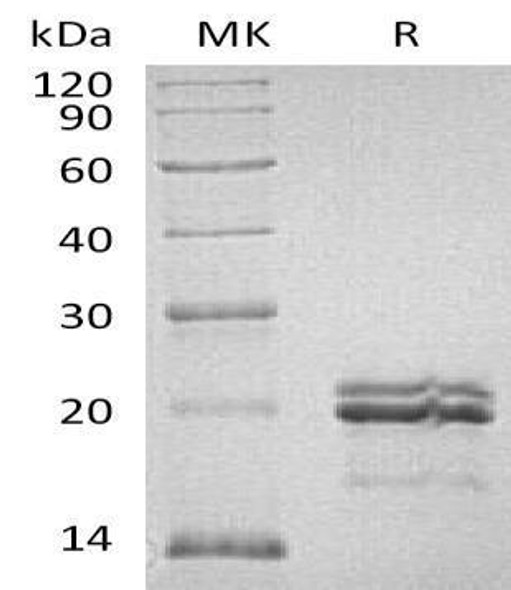Description
| Product Name: | Human MAX Recombinant Protein |
| Product Code: | RPPB3934 |
| Size: | 25µg |
| Species: | Human |
| Target: | MAX |
| Synonyms: | bHLHd4, bHLHd5, bHLHd6, bHLHd7, bHLHd8, MYC Associated Factor X, Class D basic helix-loop-helix protein 4, orf1, MGC10775, MGC11225, MGC18164, MGC34679, MGC36767, MAX Protein. |
| Source: | Escherichia Coli |
| Physical Appearance: | Sterile filtered colorless solution. |
| Formulation: | MAX Human solution containing 20mM Tris-HCl pH-8, 1mM DTT and 10% glycerol. |
| Stability: | Store at 4°C if entire vial will be used within 2-4 weeks. Store, frozen at -20°C for longer periods of time. For long term storage it is recommended to add a carrier protein (0.1% HSA or BSA).Avoid multiple freeze-thaw cycles. |
| Purity: | Greater than 90% as determined by SDS-PAGE. |
| Amino Acid Sequence: | MSDNDDIEVE SDEEQPRFQS AADKRAHHNA LERKRRDHIK DSFHSLRDSV PSLQGEKASR AQILDKATEY IQYMRRKNHT HQQDIDDLKR QNALLEQQVR ALEKARSSAQ LQTNYPSSDN SLYTNAKGST ISAFDGGSDS SSESEPEEPQ SRKKLRMEAS LEHHHHHH |
MAX protein is part of the basic helix-loop-helix leucine zipper (bHLHZ) family of transcription factors. MAX forms homodimers and heterodimers with Mad, Mxi1 and Myc. Myc is an oncoprotein implicated in cell proliferation, differentiation and apoptosis. The homodimers and heterodimers compete for a common DNA target site (the E box) and rearrangement among these dimer forms offers a complex system of transcriptional regulation. In contrast to Myc, which is exceedingly regulated throughout progression during the cell cycle, Max is very stable and is much more abundant than Myc.
MAX Human Recombinant produced in E.Coli is a single, non-glycosylated, polypeptide chain containing 168 amino acids (1-160 a.a.) and having a molecular mass of 19.3kDa. MAX protein is fused to an 8 amino acid His-Tag at C-terminus and purified by standard chromatography.
| UniProt Protein Function: | MAX: a transcription factor. Forms a DNA- binding protein complex with MYC or MAD. The MYC-MAX complex is a transcriptional activator, whereas the MAD-MAX complex is a repressor. CPG methylation of the recognition site greatly inhibits DNA binding, suggesting that DNA methylation may regulate the MYC/MAX complex in vivo. May repress transcription via the recruitment of a chromatin remodeling complex containing H3-K9 histone methyltransferase activity. Three alternatively spliced isoforms have been reported. |
| UniProt Protein Details: | Protein type:DNA-binding; Transcription factor Chromosomal Location of Human Ortholog: 14q23 Cellular Component: nucleoplasm; PML body; dendrite; cytoplasm; nucleus Molecular Function:protein binding; protein homodimerization activity; sequence-specific DNA binding; protein heterodimerization activity; transcription coactivator activity; transcription cofactor activity; protein complex binding; transcription factor activity Biological Process: transcription from RNA polymerase II promoter; neuron apoptosis; regulation of transcription, DNA-dependent; retina development in camera-type eye; protein complex assembly; response to axon injury; cellular response to starvation; response to insulin stimulus |
| NCBI Summary: | The protein encoded by this gene is a member of the basic helix-loop-helix leucine zipper (bHLHZ) family of transcription factors. It is able to form homodimers and heterodimers with other family members, which include Mad, Mxi1 and Myc. Myc is an oncoprotein implicated in cell proliferation, differentiation and apoptosis. The homodimers and heterodimers compete for a common DNA target site (the E box) and rearrangement among these dimer forms provides a complex system of transcriptional regulation. Mutations of this gene have been reported to be associated with hereditary pheochromocytoma. A pseudogene of this gene is located on the long arm of chromosome 7. Alternative splicing results in multiple transcript variants. [provided by RefSeq, Aug 2012] |
| UniProt Code: | P61244 |
| NCBI GenInfo Identifier: | 47117704 |
| NCBI Gene ID: | 4149 |
| NCBI Accession: | P61244.1 |
| UniProt Secondary Accession: | P61244,P25912, P52163, Q14803, Q96CY8, A6NH73, A8K265 A8K4G4, A8K824, |
| UniProt Related Accession: | P61244 |
| Molecular Weight: | 160 |
| NCBI Full Name: | Protein max |
| NCBI Synonym Full Names: | MYC associated factor X |
| NCBI Official Symbol: | MAX�� |
| NCBI Official Synonym Symbols: | bHLHd4�� |
| NCBI Protein Information: | protein max; class D basic helix-loop-helix protein 4 |
| UniProt Protein Name: | Protein max |
| UniProt Synonym Protein Names: | Class D basic helix-loop-helix protein 4; bHLHd4; Myc-associated factor X |
| Protein Family: | Protein max |
| UniProt Gene Name: | MAX�� |
| UniProt Entry Name: | MAX_HUMAN |






